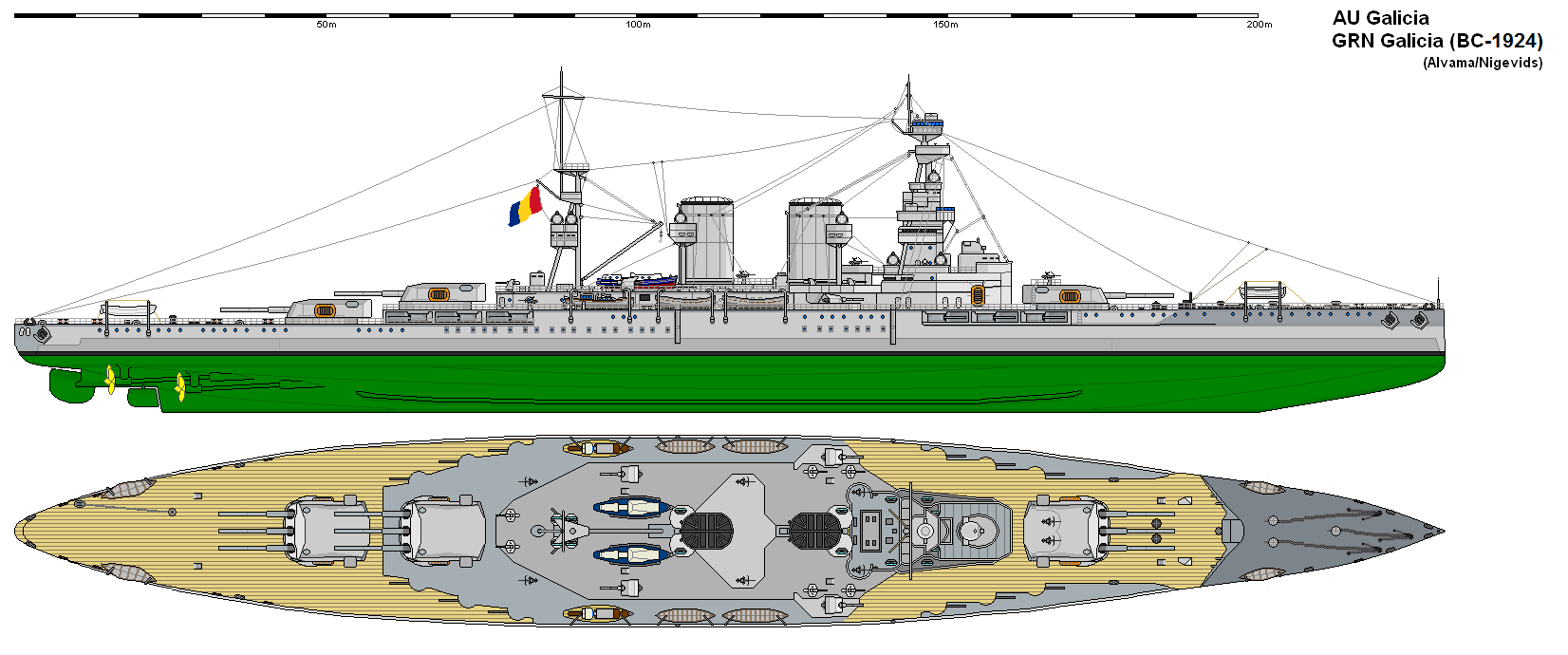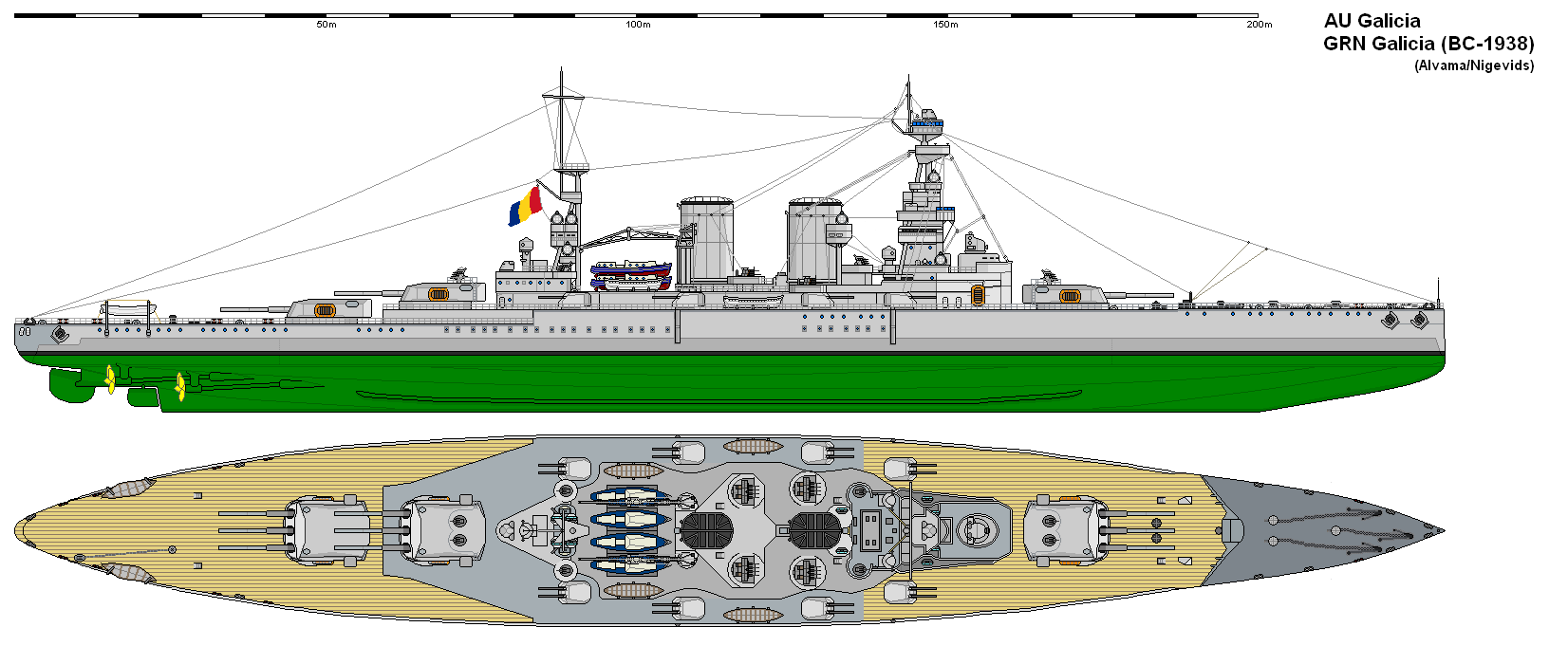
GRN Galicia (BC-1924 (1938-mod))
In Jan/Feb of 1919 the victorious Allies undertook a survey of the Austro-Hungarian shipyards in which they discovered three ships ranging from 75-85% complete. There were two battleships and one battlecruiser. The battlecruiser was the nearest to completion (launched as the Prinz Asturias) having all the main and secondary armament fitted while the machinery was installed but had never been run. The main item missing was the bridge superstructure and ancillary equipment. The ship had been designed to break out through the Adriatic Narrows into the Mediterranean to disrupt and sink Allied shipping. Two Admiralty tugs were sent to Trieste where they took the ship in tow, destination Devonport. On arrival the ship was commissioned into the Galician Navy as the GRN Galicia. Berthed for completion in the dock next to where HMS Furious was undergoing reconstruction to an aircraft carrier, as the superstructure of Furious was removed it was refitted to the Galicia. This kept the cost of the ships completion to an absolute minimum, while providing it with up to date equipment not more than 3-5 years old. The most expensive part of the fitting out was the changing of the engines from coal fired to oil fired.
Out of
the ashes of the First World War rises a new entity that was to be called Galicia, brought into being
by the Geneva Great War Treaty which using its magic wand (otherwise known as Nigevids) took pieces from three of the Central Powers and Russia to create a
new land big enough to be able to fend for itself against its major neighbours.
Part of the setting up of the new Galician Navy was the gift of some of the
ships surrendered to the Western Allies. However by its start up treaty the
Galician Navy had to base its capital ships in the Black Sea as a blockade force
against Russia.

In terms of ships completed for the Central Powers the Prinz Asturias was huge. With three triple turrets of the 13.75" guns developed in tandem by the Germanic States and Austro-Hungarian Navies the ship had 1 more gun than the Mackensen class ships and one less gun than the Monarch class ships. Secondary armament contained sixteen 5.9" guns in casemates. Six 88mm AA guns and 8 2pd AA guns rounded out a more than useful armament. Size of the ship was dependent on how fast the ship was supposed to go. The faster the ship, the larger the ship needed to be to contain the propulsion system required to obtain the horsepower for the eventual speed. This may sound strange but the whole reason the Hood was so huge was the speed demand of 32 knots. Lower that to 29/30 knots the same as the Renown's and the Hood would have been a great deal smaller.

In 1934 having watched the first steps of the other Western powers to
modernise their older warships, the Galicia was taken in hand at Constanta for a
refurbishment of her systems and armament. Due to the ordering of the three new
ships money for Galicia's rebuilding was to be kept to a minimum. The secondary
and AA weapons were to be upgraded but the superstructure, armour and hull were
left untouched. The best part of the refit was the fitting of the new twin 125mm
(4.9") dual purpose turrets and guns. The removal and plating in of the old 5.9"
casemate guns gave weight back to allow for the new weapons.
| Displacement | As built 32,700 tons std 41,800 tons full load |
As rebuilt 1936-38 33,250 tons std 44,400 tons full load |
| Length | 753.5 ft | |
| Breadth | 101 ft | |
| Draught | 28 ft | |
| Machinery | 4 shaft steam turbines, 110,000shp | |
| Speed | 28 knots | |
| Range | 6000 miles at 15 knots (2500 at 28knots) | |
| Armour | 10" side, 5.1" deck, 12"/9"/6" turrets | |
| Armament | As built 9 x 13.75" (3x3) 16 x 5.9" (16x1) 6 x 88mm (6x1) 8 x 2pd AA (8x1) |
As Rebuilt 1936-38 9 x 13.75" (3x3) 16 x 125mm (4.9") (8x2) 32 x 2pd (4x8) 32 x 0.5"mg (8x4) |
| Aircraft | nil | |
| Torpedoes | nil | |
| Complement | 1950 | |
| Notes | GRN Galicia | |